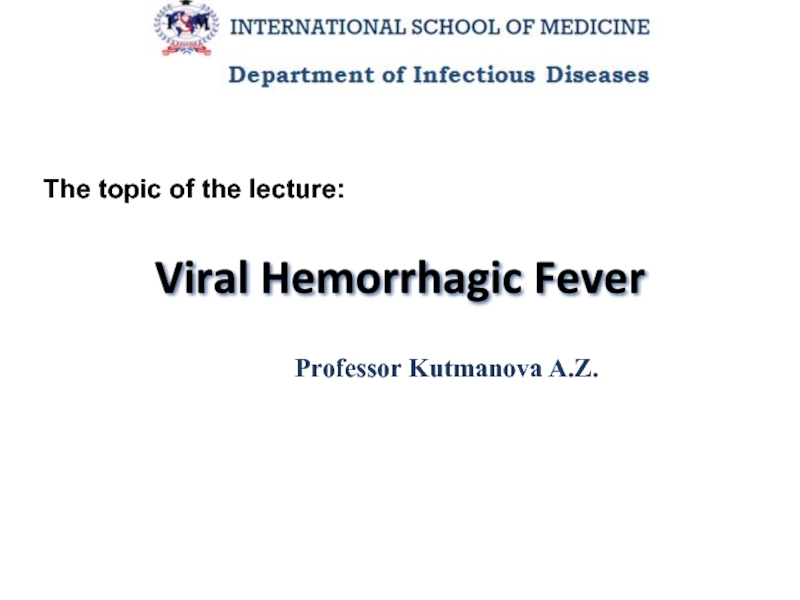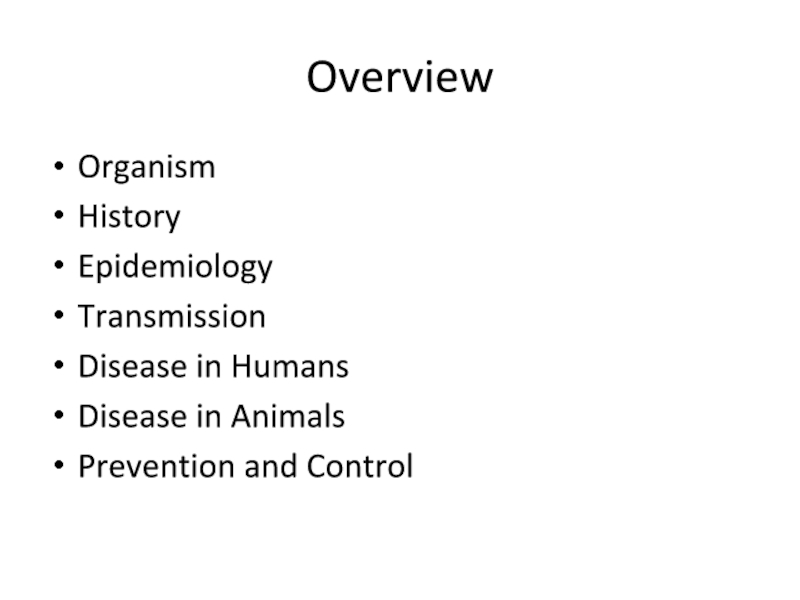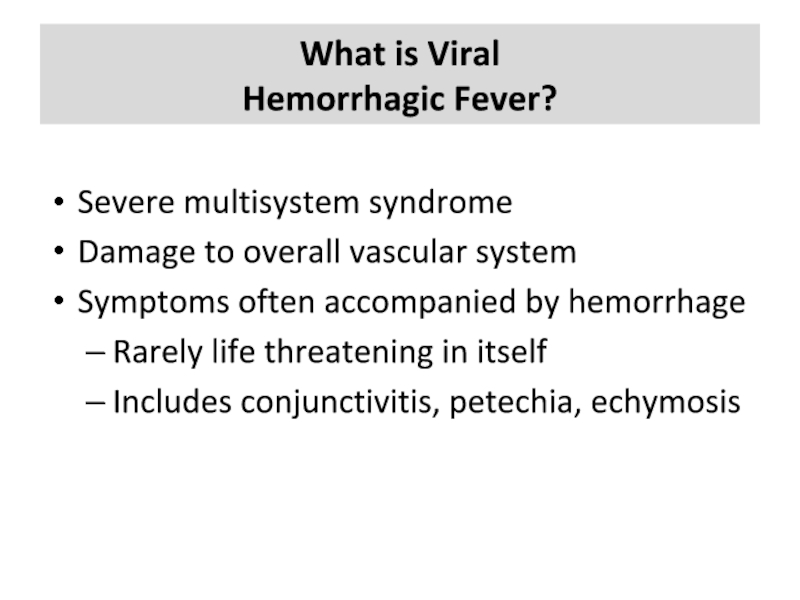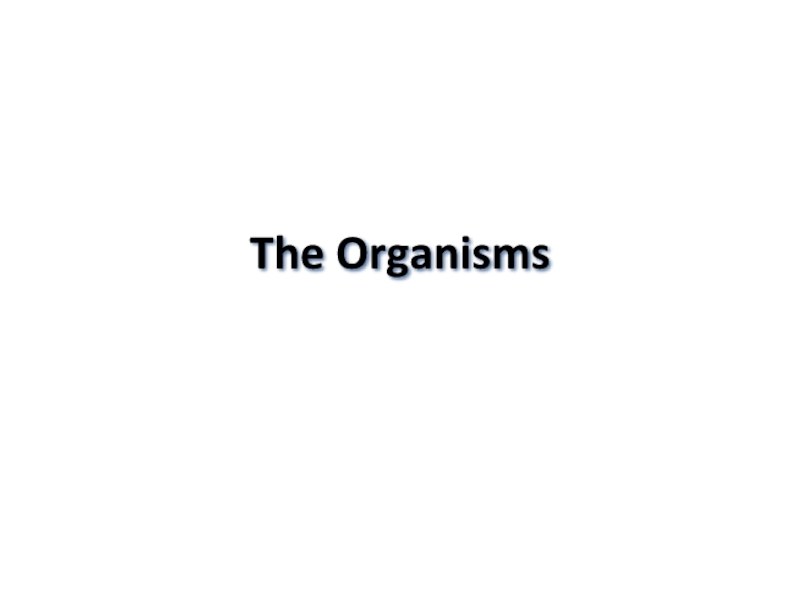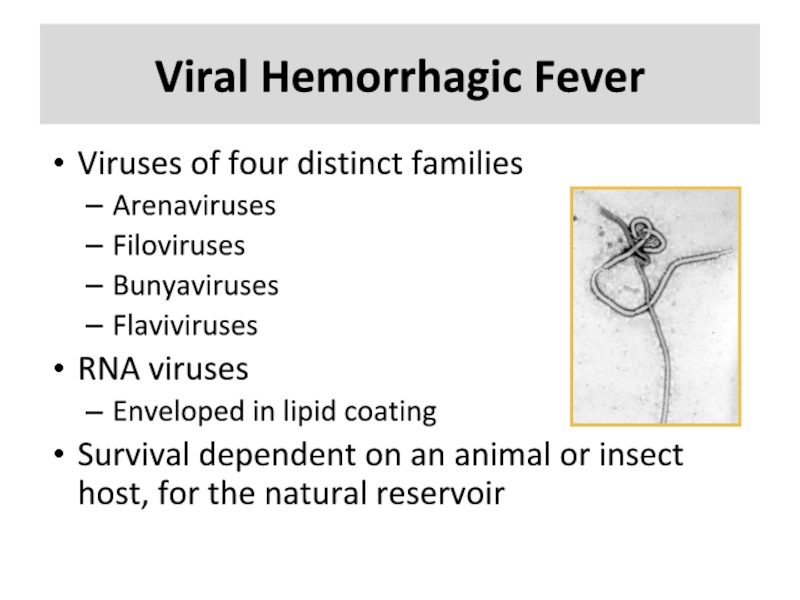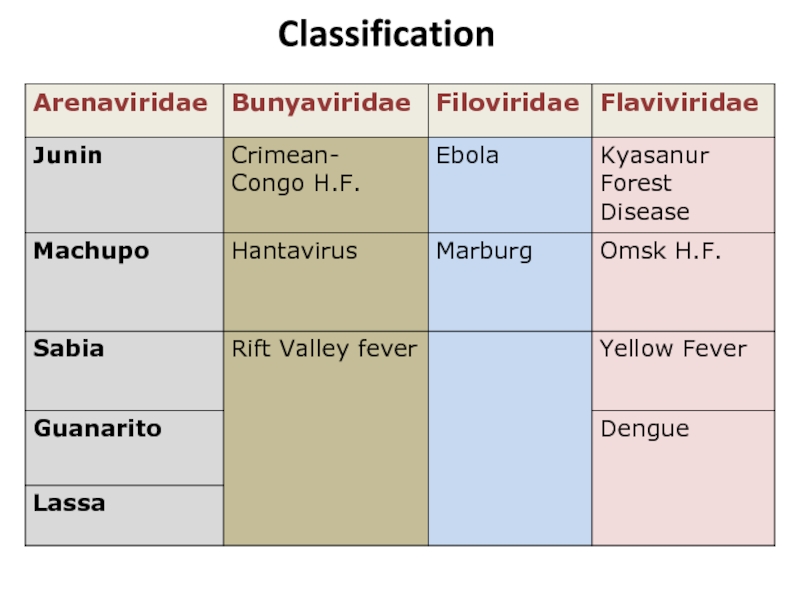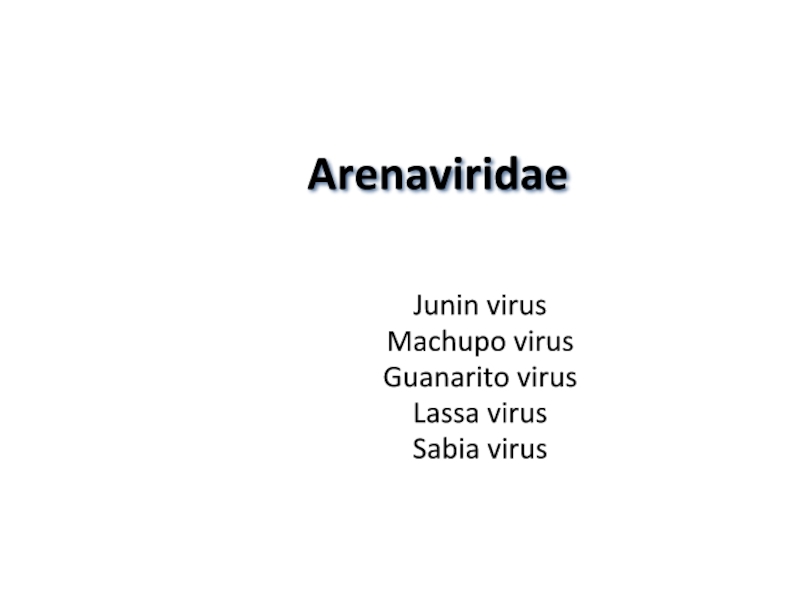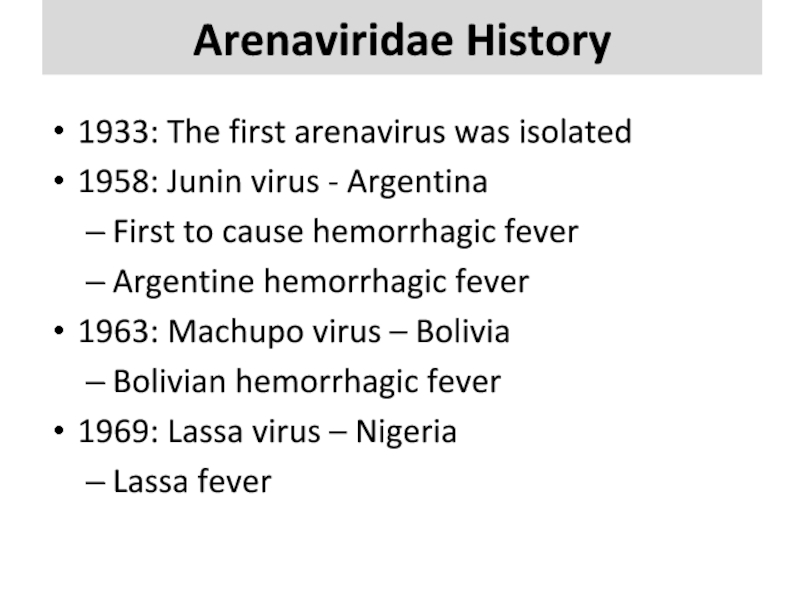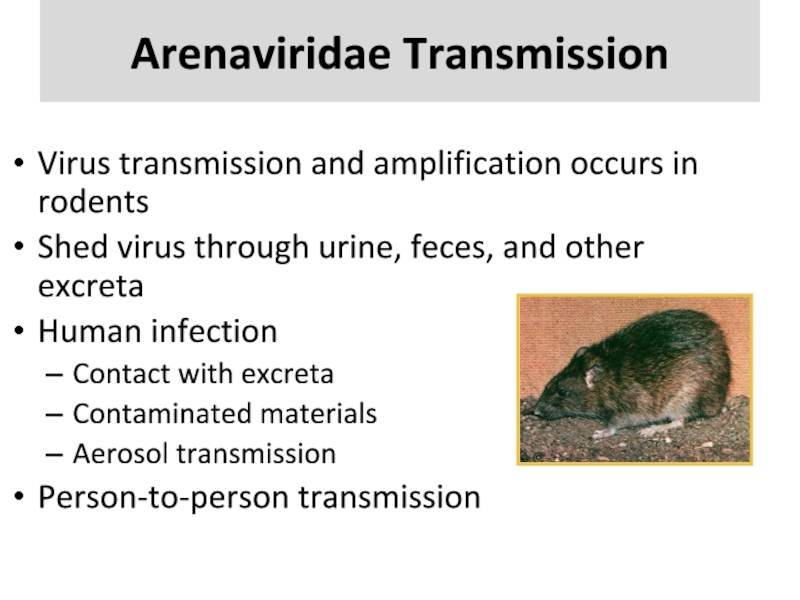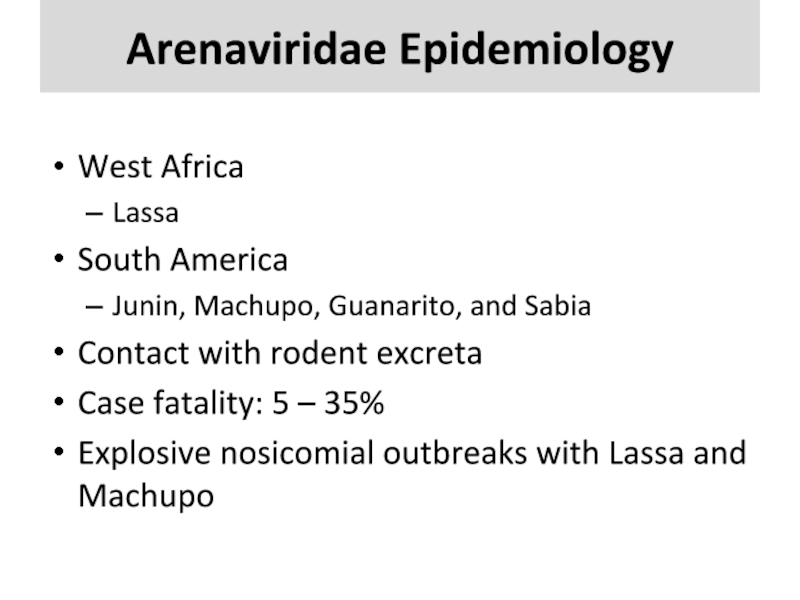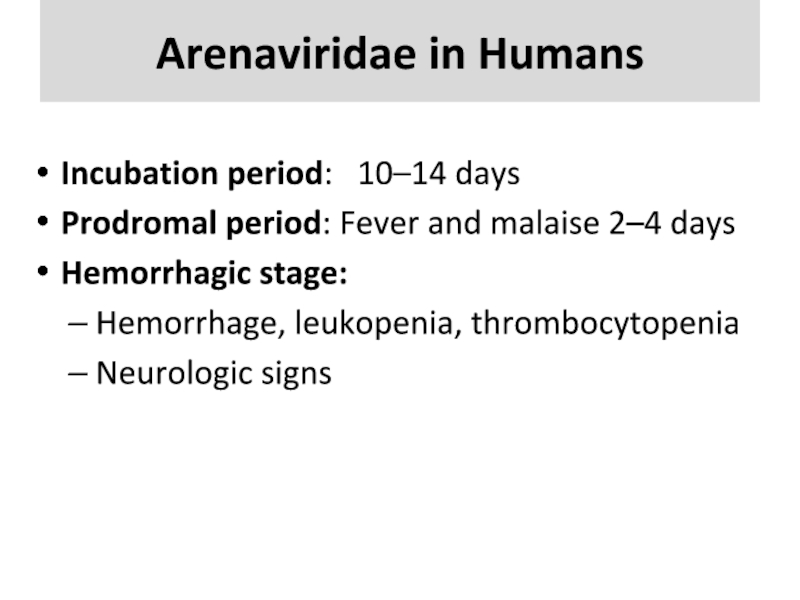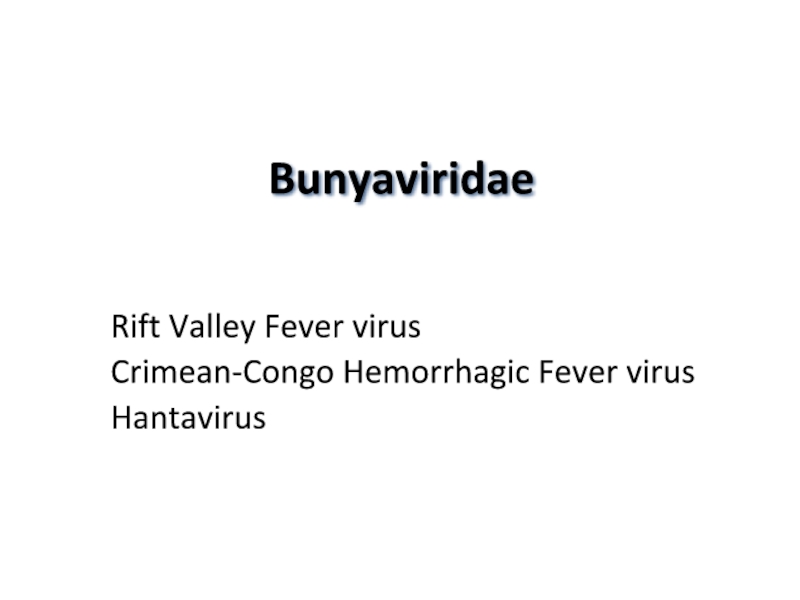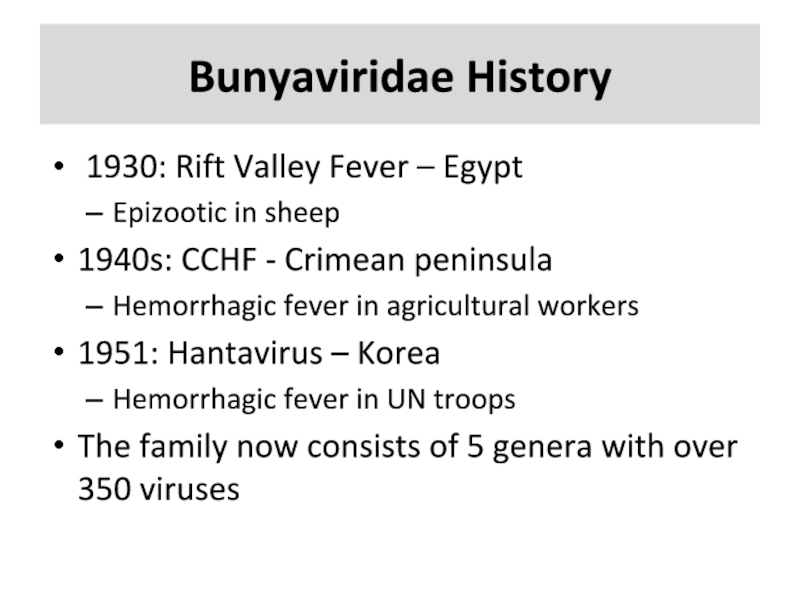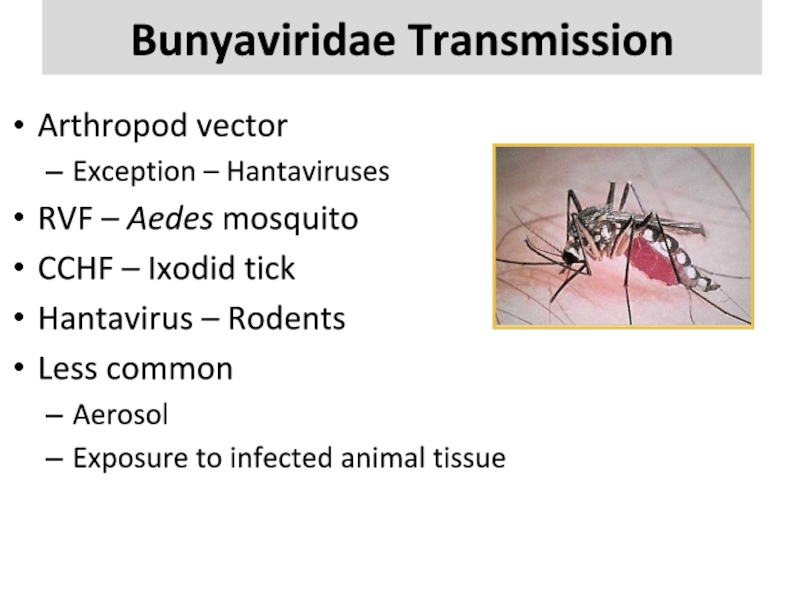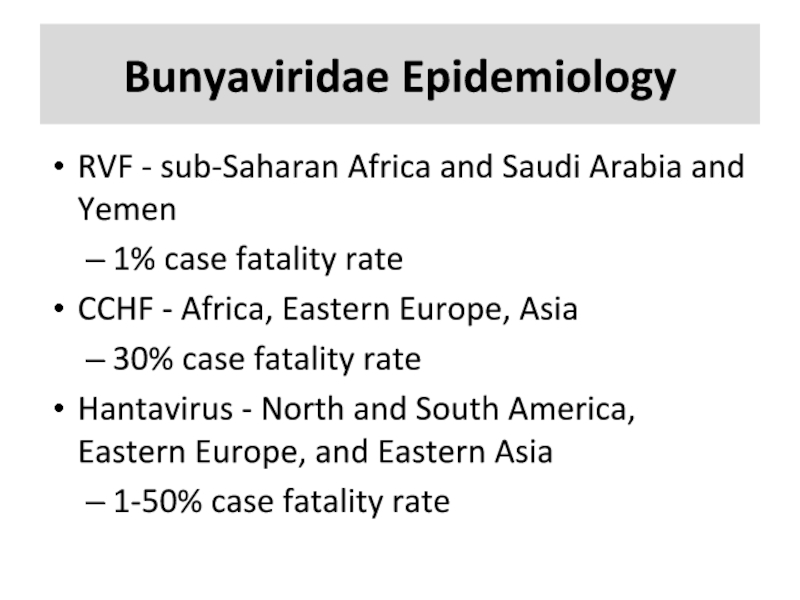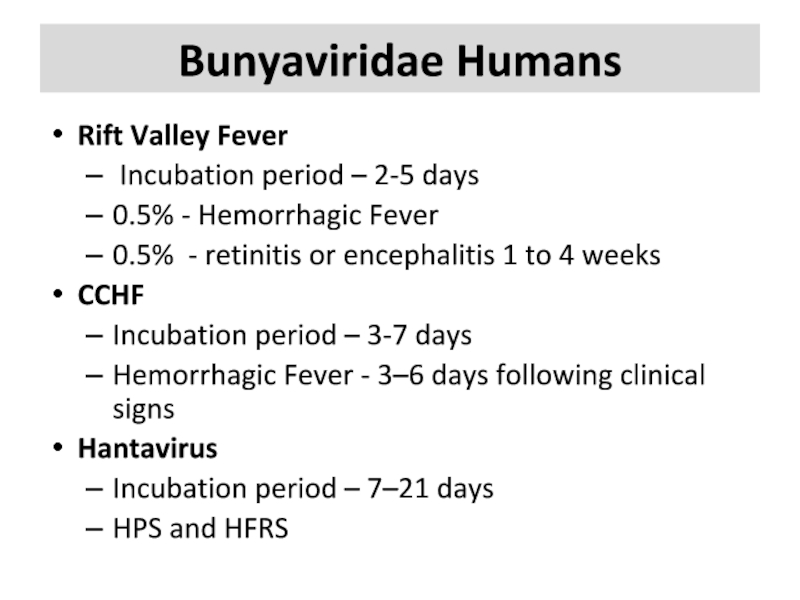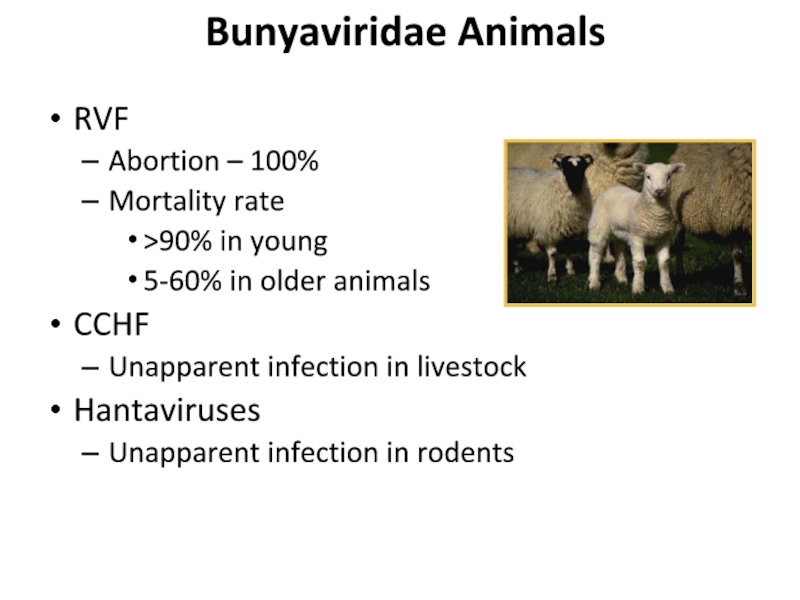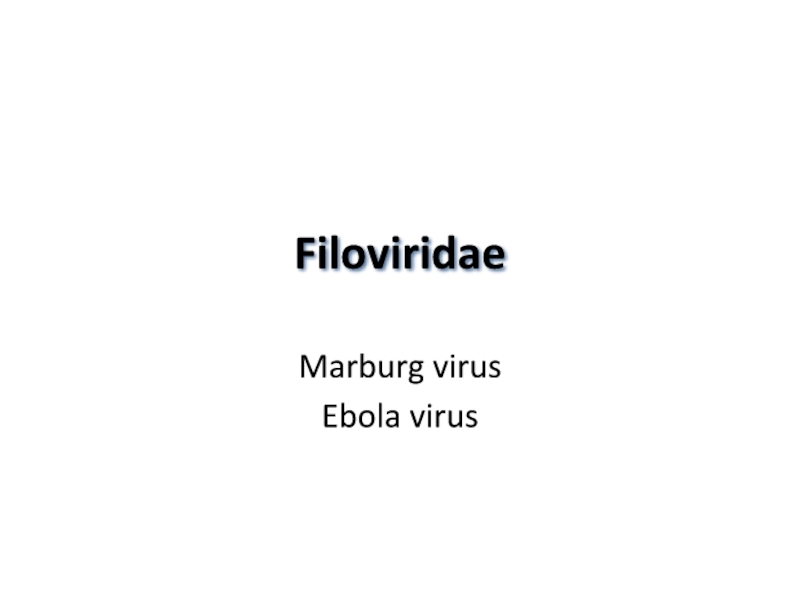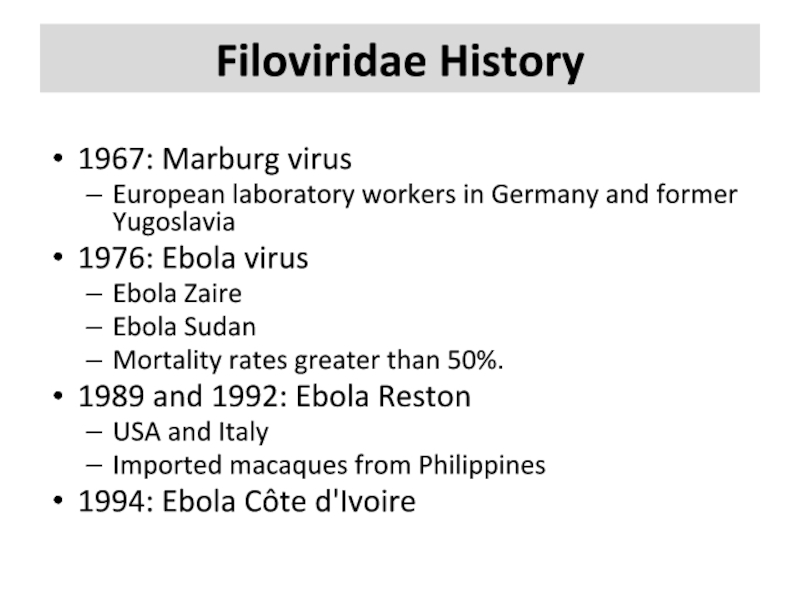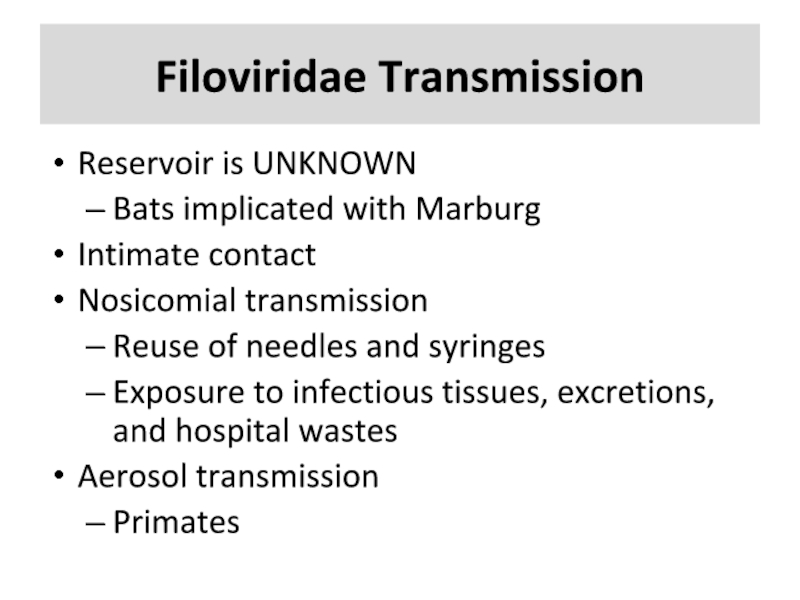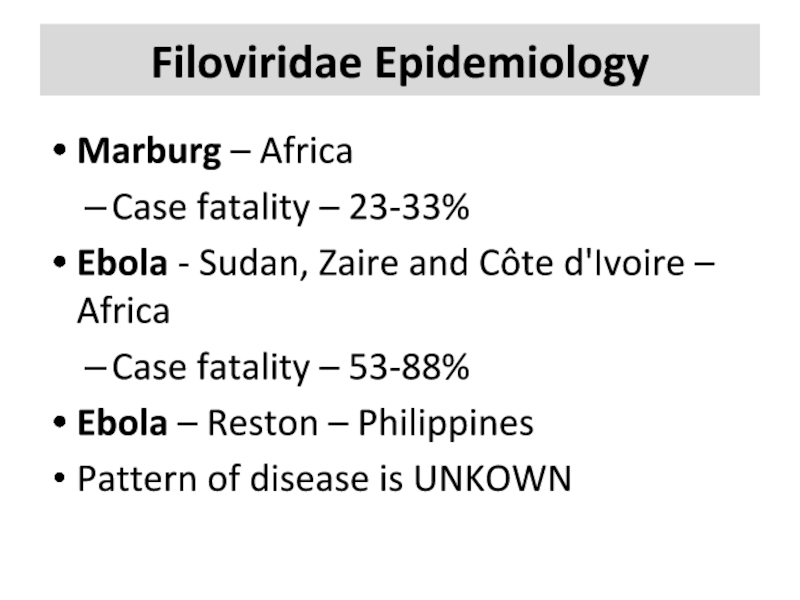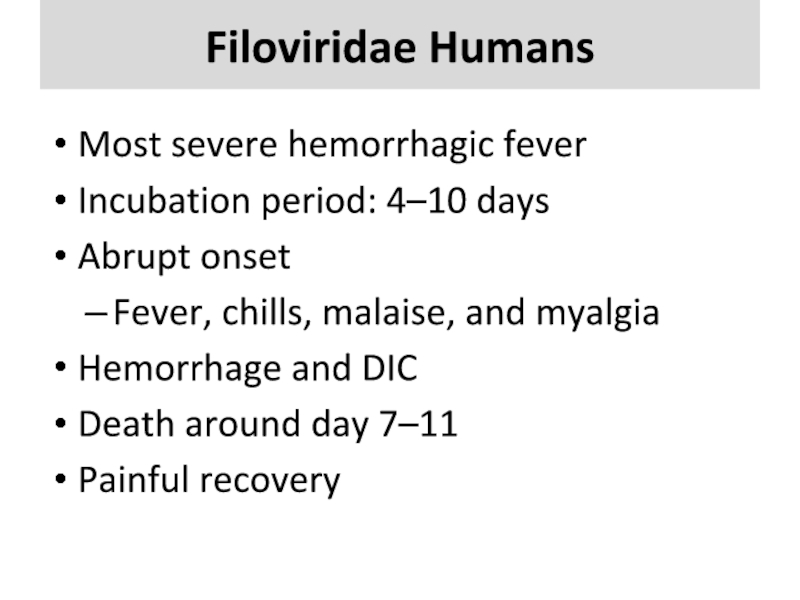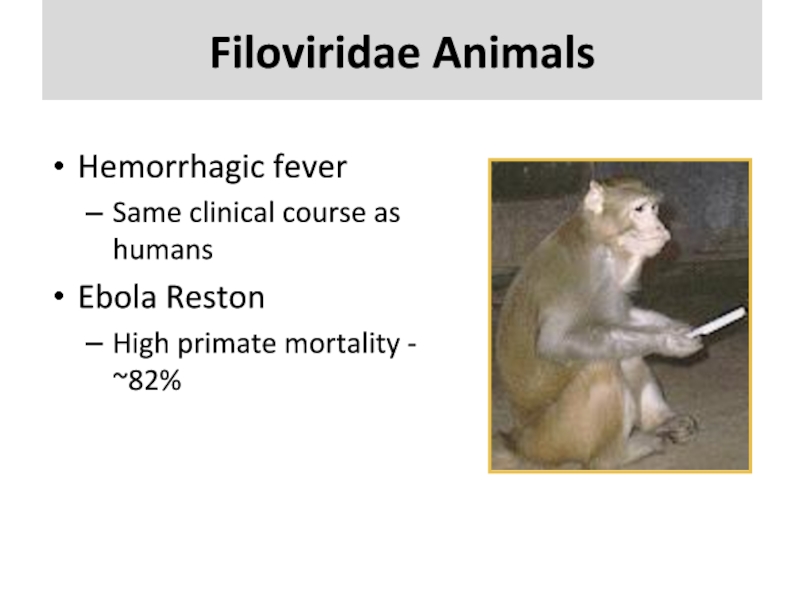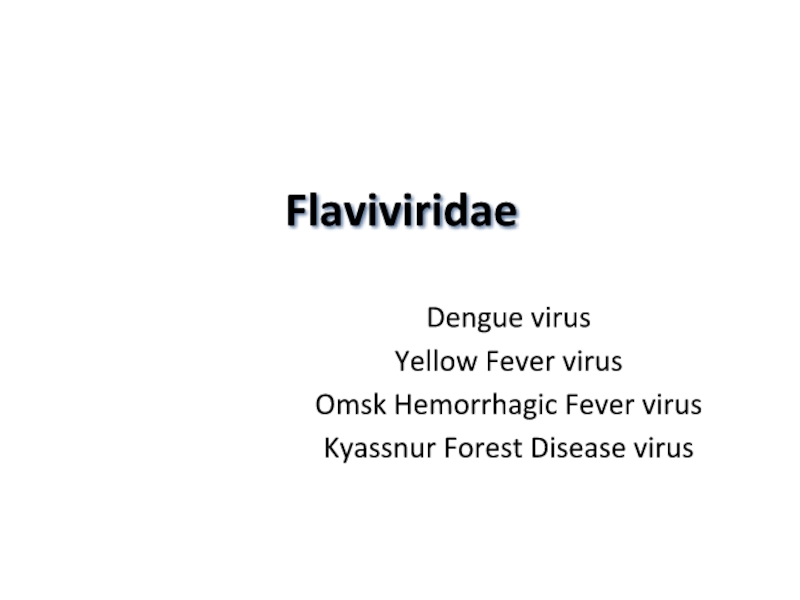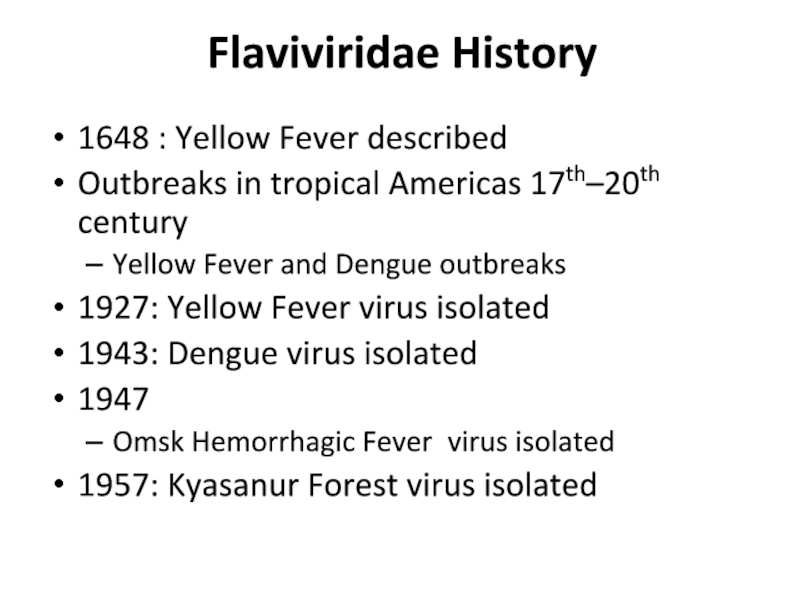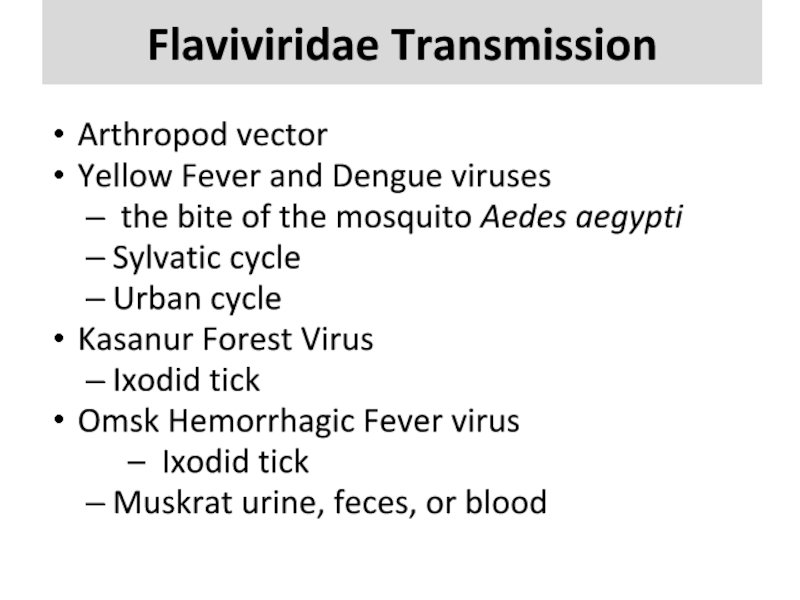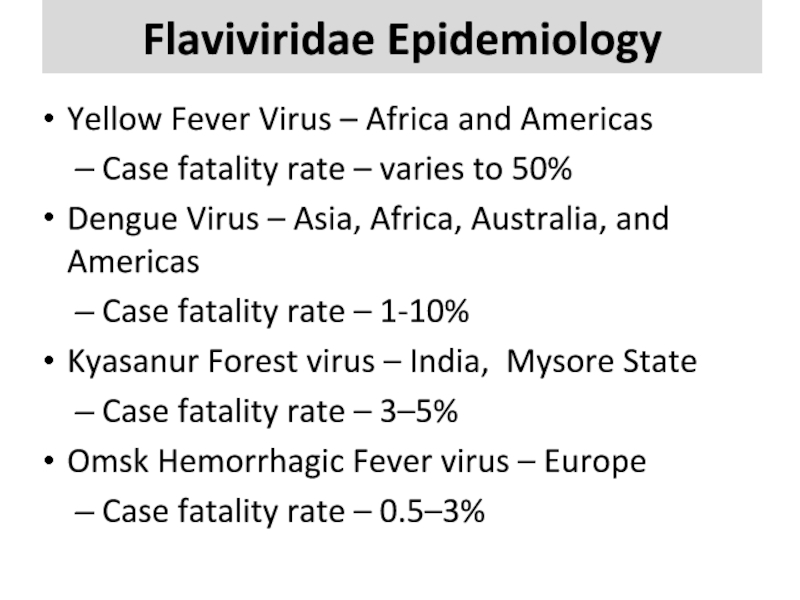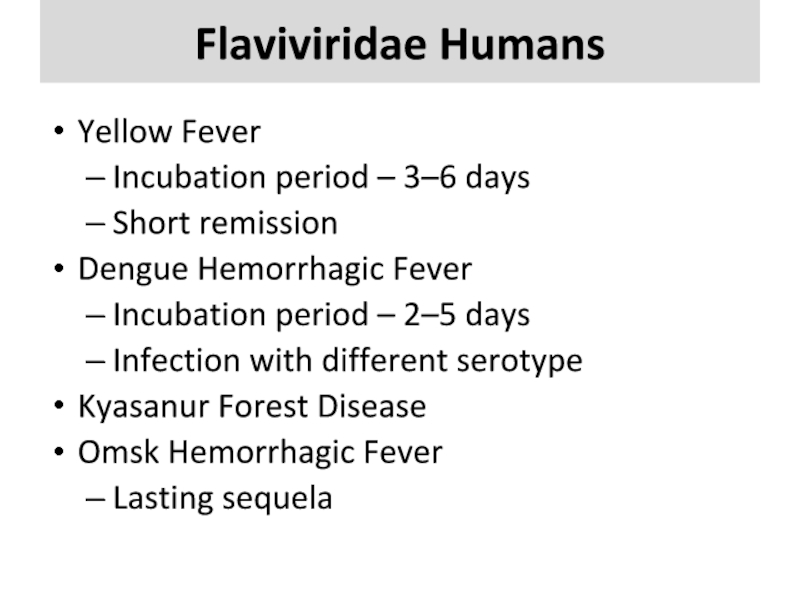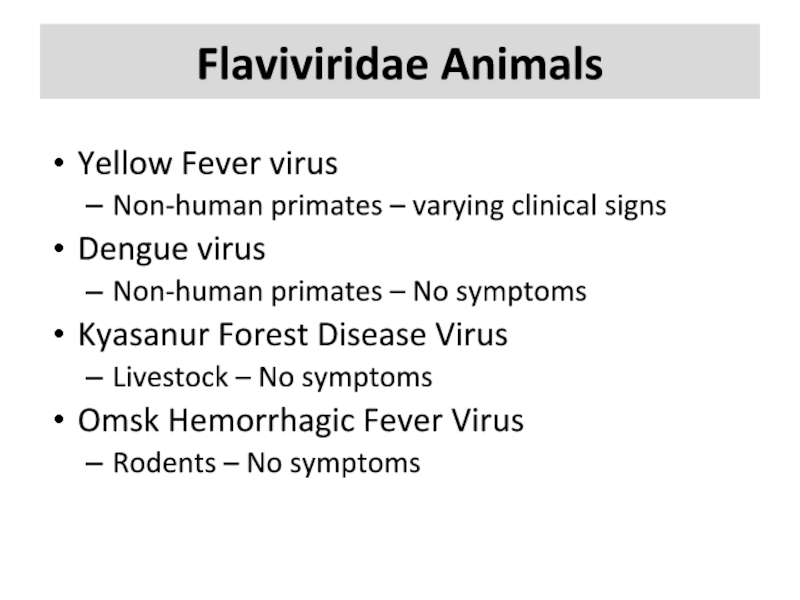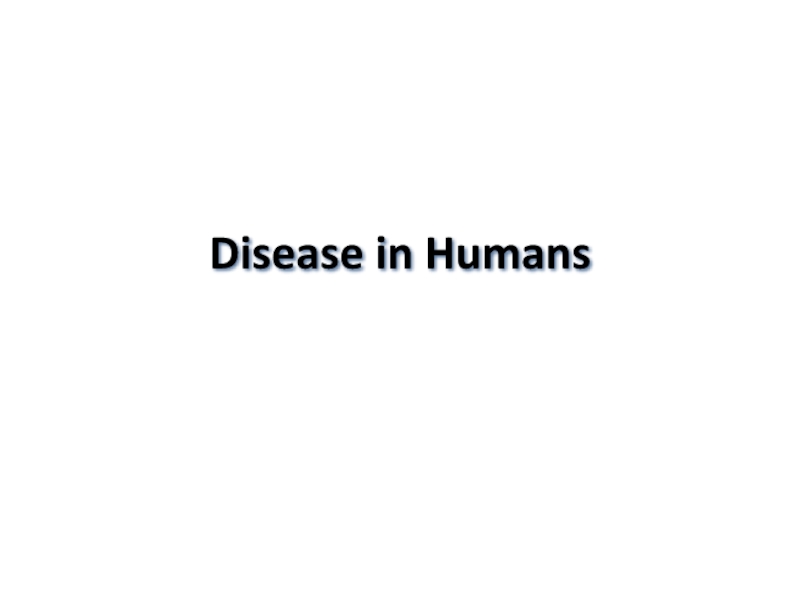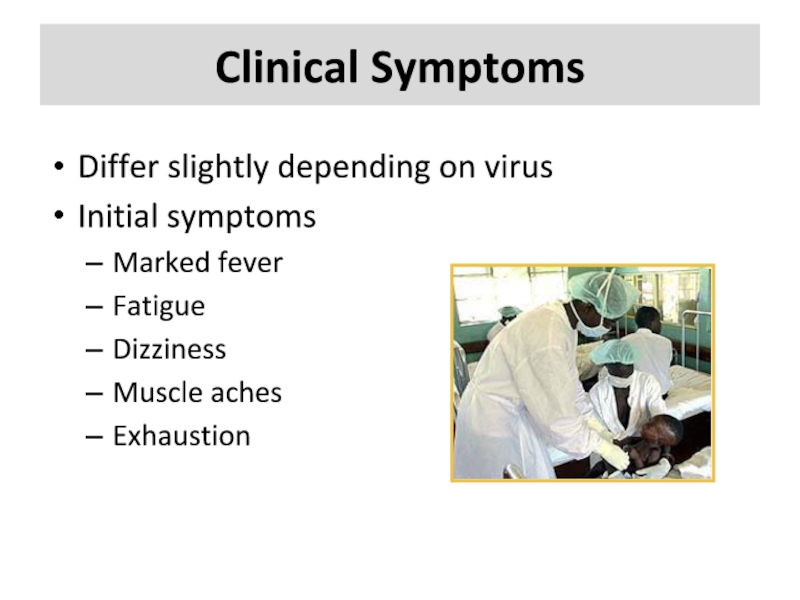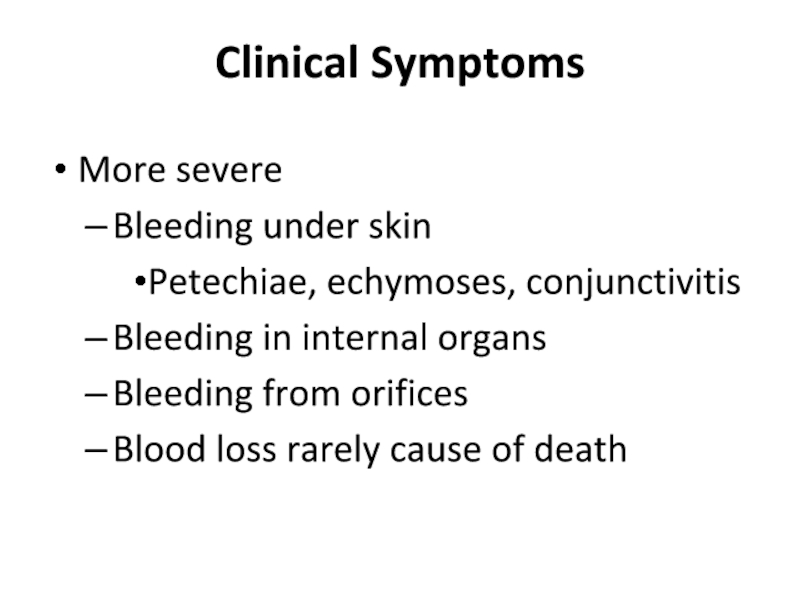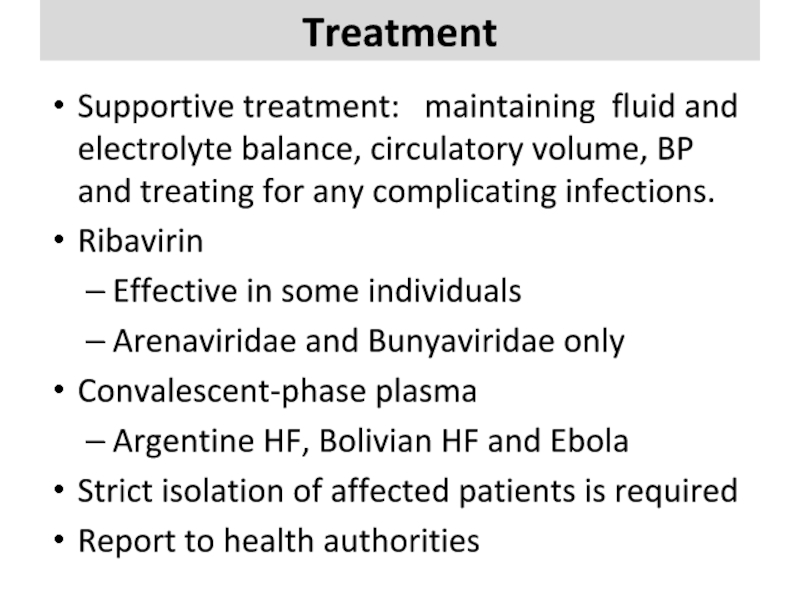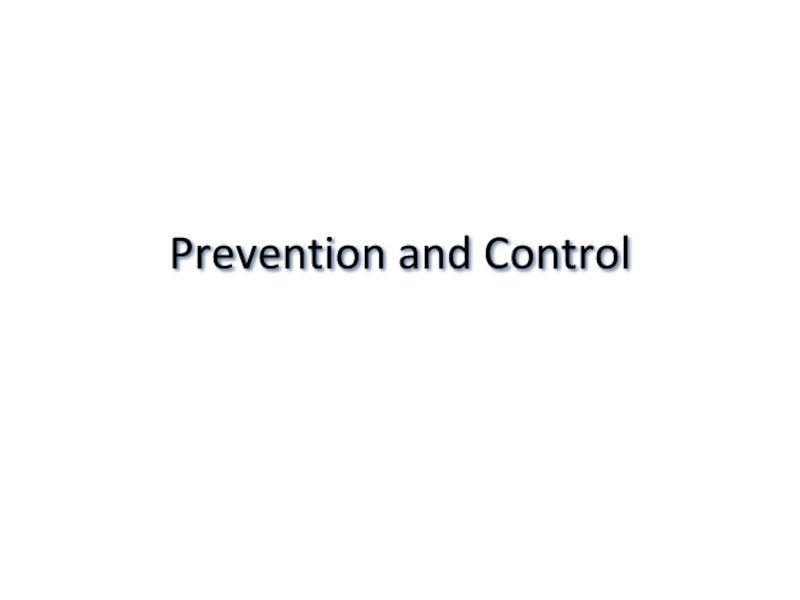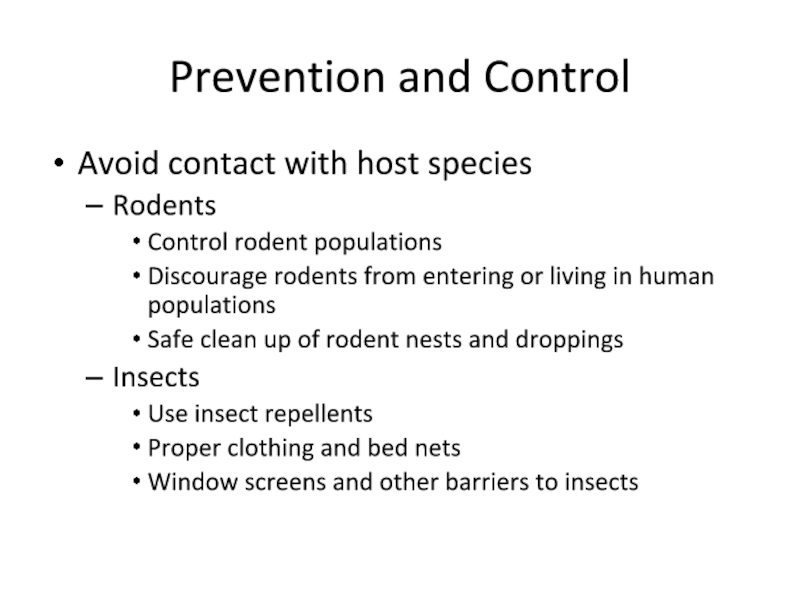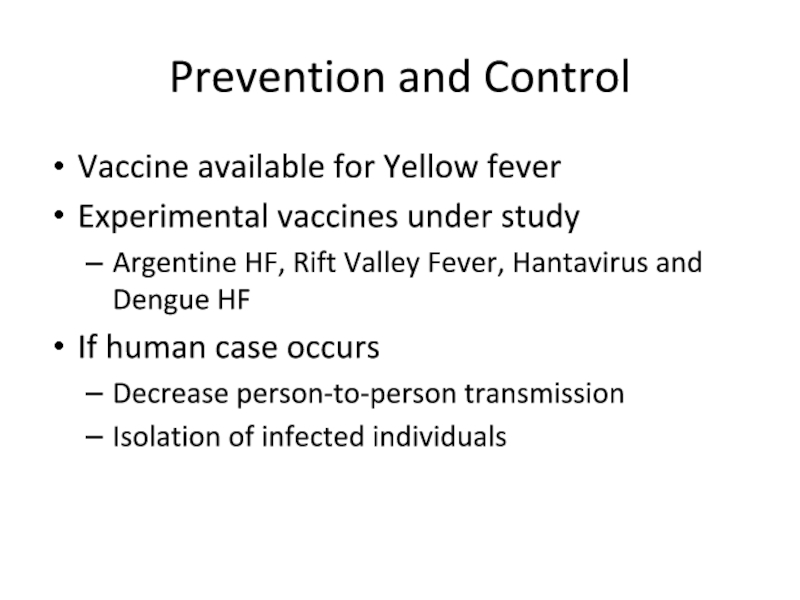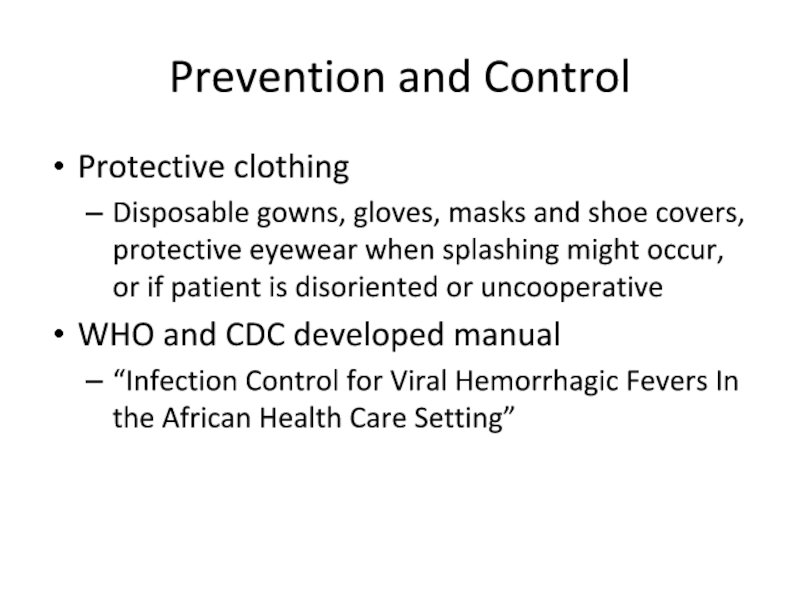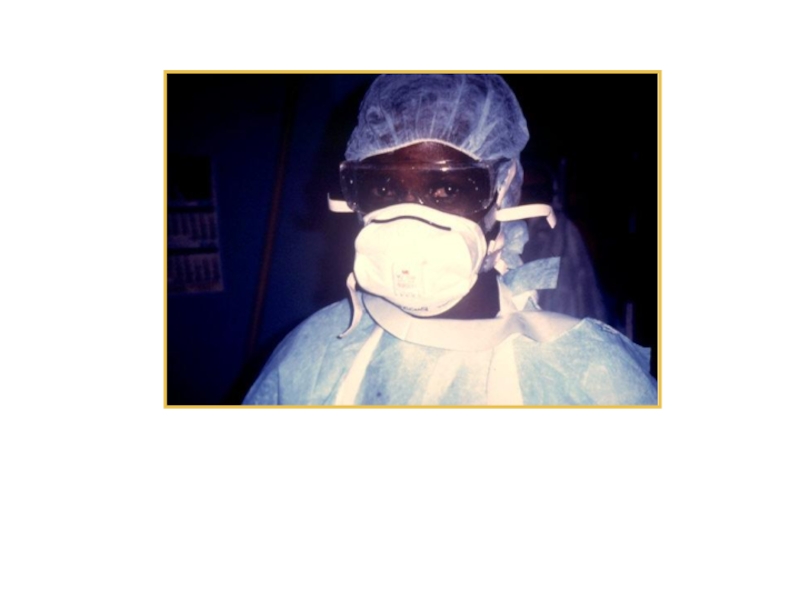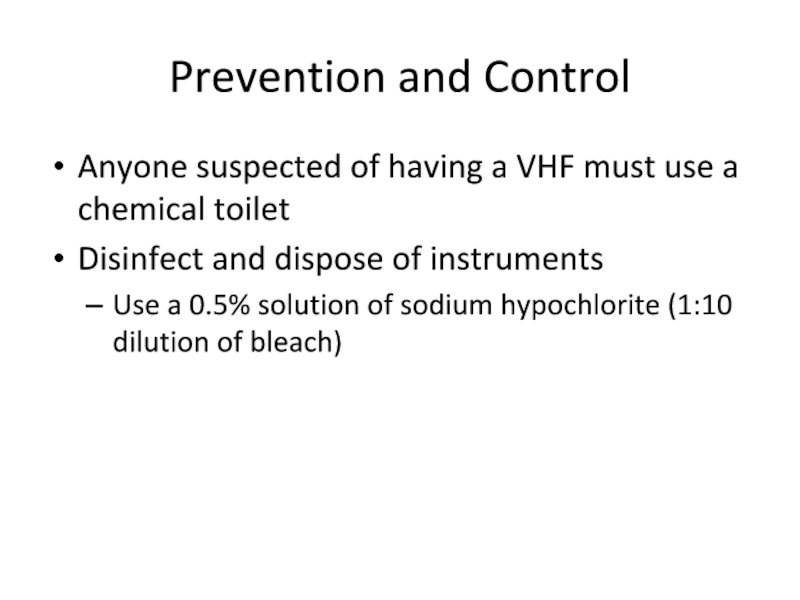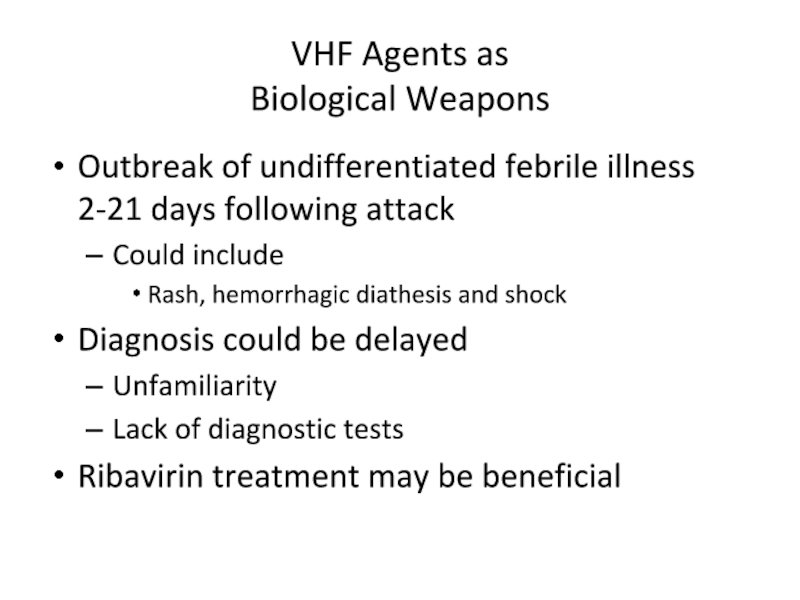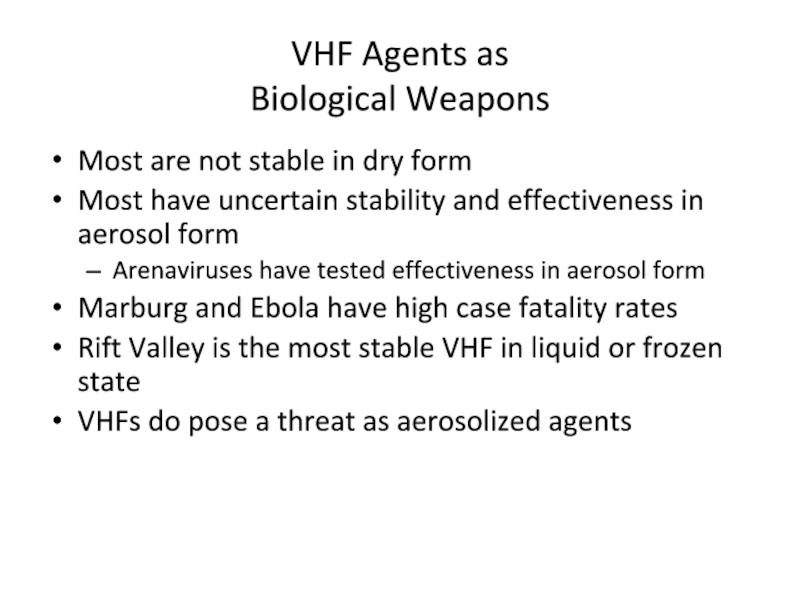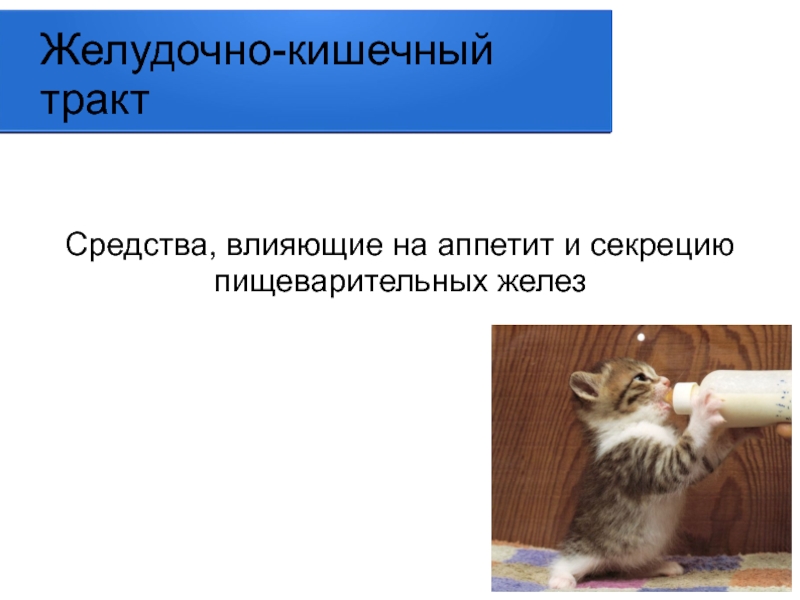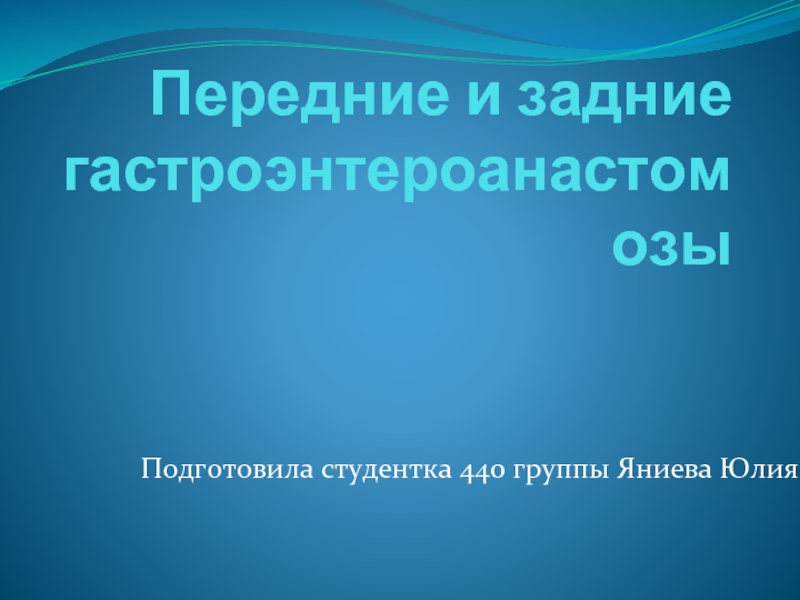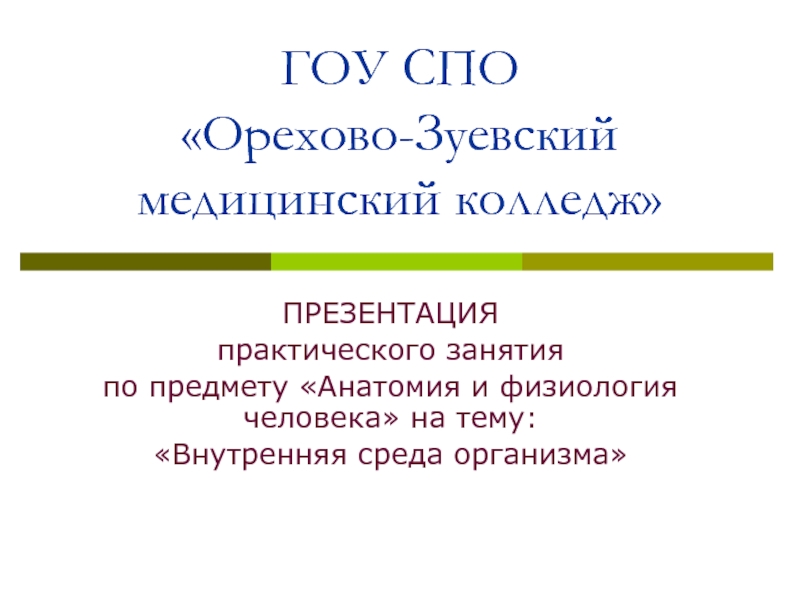- Главная
- Разное
- Дизайн
- Бизнес и предпринимательство
- Аналитика
- Образование
- Развлечения
- Красота и здоровье
- Финансы
- Государство
- Путешествия
- Спорт
- Недвижимость
- Армия
- Графика
- Культурология
- Еда и кулинария
- Лингвистика
- Английский язык
- Астрономия
- Алгебра
- Биология
- География
- Детские презентации
- Информатика
- История
- Литература
- Маркетинг
- Математика
- Медицина
- Менеджмент
- Музыка
- МХК
- Немецкий язык
- ОБЖ
- Обществознание
- Окружающий мир
- Педагогика
- Русский язык
- Технология
- Физика
- Философия
- Химия
- Шаблоны, картинки для презентаций
- Экология
- Экономика
- Юриспруденция
Viral Hemorrhagic Fever презентация
Содержание
- 1. Viral Hemorrhagic Fever
- 2. Overview Organism History Epidemiology Transmission Disease in Humans Disease in Animals Prevention and Control
- 3. What is Viral Hemorrhagic Fever? Severe
- 4. The Organisms
- 5. Viral Hemorrhagic Fever Viruses of four distinct
- 6. Classification
- 7. Arenaviridae Junin virus Machupo virus Guanarito virus Lassa virus Sabia virus
- 8. Arenaviridae History 1933: The first arenavirus was
- 9. Arenaviridae Transmission Virus transmission and amplification occurs
- 10. Arenaviridae Epidemiology West Africa Lassa South
- 11. Arenaviridae in Humans Incubation period: 10–14
- 12. Bunyaviridae Rift Valley Fever virus Crimean-Congo Hemorrhagic Fever virus Hantavirus
- 13. Bunyaviridae History 1930: Rift Valley Fever
- 14. Bunyaviridae Transmission Arthropod vector Exception – Hantaviruses
- 15. Bunyaviridae Epidemiology RVF - sub-Saharan Africa and
- 16. Bunyaviridae Humans Rift Valley Fever
- 17. Bunyaviridae Animals RVF Abortion – 100% Mortality
- 18. Filoviridae Marburg virus Ebola virus
- 19. Filoviridae History 1967: Marburg virus European laboratory
- 20. Filoviridae Transmission Reservoir is UNKNOWN Bats
- 21. Filoviridae Epidemiology Marburg – Africa Case fatality
- 22. Filoviridae Humans Most severe hemorrhagic fever Incubation
- 23. Filoviridae Animals Hemorrhagic fever Same clinical course
- 24. Flaviviridae Dengue virus Yellow Fever virus Omsk Hemorrhagic Fever virus Kyassnur Forest Disease virus
- 25. Flaviviridae History 1648 : Yellow Fever described
- 26. Flaviviridae Transmission Arthropod vector Yellow Fever and
- 27. Flaviviridae Epidemiology Yellow Fever Virus – Africa
- 28. Flaviviridae Humans Yellow Fever Incubation period
- 29. Flaviviridae Animals Yellow Fever virus Non-human primates
- 30. Disease in Humans
- 31. Clinical Symptoms Differ slightly depending on virus
- 32. Clinical Symptoms More severe Bleeding under
- 33. Diagnosis Specimens must be sent to CDC
- 34. Treatment Supportive treatment: maintaining fluid and
- 35. Prevention and Control
- 36. Prevention and Control Avoid contact with host
- 37. Prevention and Control Vaccine available for Yellow
- 38. Prevention and Control Protective clothing Disposable gowns,
- 39. Protective equipment worn by a nurse during Ebola outbreak in Zaire, 1995
- 40. Prevention and Control Anyone suspected of having
- 41. VHF Agents as Biological Weapons Outbreak
- 42. VHF Agents as Biological Weapons Most
Слайд 2Overview
Organism
History
Epidemiology
Transmission
Disease in Humans
Disease in Animals
Prevention and Control
Слайд 3What is Viral
Hemorrhagic Fever?
Severe multisystem syndrome
Damage to overall
vascular system
Symptoms often accompanied by hemorrhage
Rarely life threatening in itself
Includes conjunctivitis, petechia, echymosis
Symptoms often accompanied by hemorrhage
Rarely life threatening in itself
Includes conjunctivitis, petechia, echymosis
Слайд 5Viral Hemorrhagic Fever
Viruses of four distinct families
Arenaviruses
Filoviruses
Bunyaviruses
Flaviviruses
RNA viruses
Enveloped in
lipid coating
Survival dependent on an animal or insect host, for the natural reservoir
Survival dependent on an animal or insect host, for the natural reservoir
Слайд 8Arenaviridae History
1933: The first arenavirus was isolated
1958: Junin virus -
Argentina
First to cause hemorrhagic fever
Argentine hemorrhagic fever
1963: Machupo virus – Bolivia
Bolivian hemorrhagic fever
1969: Lassa virus – Nigeria
Lassa fever
First to cause hemorrhagic fever
Argentine hemorrhagic fever
1963: Machupo virus – Bolivia
Bolivian hemorrhagic fever
1969: Lassa virus – Nigeria
Lassa fever
Слайд 9Arenaviridae Transmission
Virus transmission and amplification occurs in rodents
Shed virus through urine,
feces, and other excreta
Human infection
Contact with excreta
Contaminated materials
Aerosol transmission
Person-to-person transmission
Human infection
Contact with excreta
Contaminated materials
Aerosol transmission
Person-to-person transmission
Слайд 10Arenaviridae Epidemiology
West Africa
Lassa
South America
Junin, Machupo, Guanarito, and Sabia
Contact with
rodent excreta
Case fatality: 5 – 35%
Explosive nosicomial outbreaks with Lassa and Machupo
Case fatality: 5 – 35%
Explosive nosicomial outbreaks with Lassa and Machupo
Слайд 11Arenaviridae in Humans
Incubation period: 10–14 days
Prodromal period: Fever and malaise
2–4 days
Hemorrhagic stage:
Hemorrhage, leukopenia, thrombocytopenia
Neurologic signs
Hemorrhagic stage:
Hemorrhage, leukopenia, thrombocytopenia
Neurologic signs
Слайд 13Bunyaviridae History
1930: Rift Valley Fever – Egypt
Epizootic in sheep
1940s: CCHF
- Crimean peninsula
Hemorrhagic fever in agricultural workers
1951: Hantavirus – Korea
Hemorrhagic fever in UN troops
The family now consists of 5 genera with over 350 viruses
Hemorrhagic fever in agricultural workers
1951: Hantavirus – Korea
Hemorrhagic fever in UN troops
The family now consists of 5 genera with over 350 viruses
Слайд 14Bunyaviridae Transmission
Arthropod vector
Exception – Hantaviruses
RVF – Aedes mosquito
CCHF – Ixodid
tick
Hantavirus – Rodents
Less common
Aerosol
Exposure to infected animal tissue
Hantavirus – Rodents
Less common
Aerosol
Exposure to infected animal tissue
Слайд 15Bunyaviridae Epidemiology
RVF - sub-Saharan Africa and Saudi Arabia and Yemen
1%
case fatality rate
CCHF - Africa, Eastern Europe, Asia
30% case fatality rate
Hantavirus - North and South America, Eastern Europe, and Eastern Asia
1-50% case fatality rate
CCHF - Africa, Eastern Europe, Asia
30% case fatality rate
Hantavirus - North and South America, Eastern Europe, and Eastern Asia
1-50% case fatality rate
Слайд 16Bunyaviridae Humans
Rift Valley Fever
Incubation period – 2-5 days
0.5% -
Hemorrhagic Fever
0.5% - retinitis or encephalitis 1 to 4 weeks
CCHF
Incubation period – 3-7 days
Hemorrhagic Fever - 3–6 days following clinical signs
Hantavirus
Incubation period – 7–21 days
HPS and HFRS
0.5% - retinitis or encephalitis 1 to 4 weeks
CCHF
Incubation period – 3-7 days
Hemorrhagic Fever - 3–6 days following clinical signs
Hantavirus
Incubation period – 7–21 days
HPS and HFRS
Слайд 17Bunyaviridae Animals
RVF
Abortion – 100%
Mortality rate
>90% in young
5-60% in older animals
CCHF
Unapparent
infection in livestock
Hantaviruses
Unapparent infection in rodents
Hantaviruses
Unapparent infection in rodents
Слайд 19Filoviridae History
1967: Marburg virus
European laboratory workers in Germany and former Yugoslavia
1976: Ebola virus
Ebola Zaire
Ebola Sudan
Mortality rates greater than 50%.
1989 and 1992: Ebola Reston
USA and Italy
Imported macaques from Philippines
1994: Ebola Côte d'Ivoire
Слайд 20Filoviridae Transmission
Reservoir is UNKNOWN
Bats implicated with Marburg
Intimate contact
Nosicomial transmission
Reuse of
needles and syringes
Exposure to infectious tissues, excretions, and hospital wastes
Aerosol transmission
Primates
Exposure to infectious tissues, excretions, and hospital wastes
Aerosol transmission
Primates
Слайд 21Filoviridae Epidemiology
Marburg – Africa
Case fatality – 23-33%
Ebola - Sudan, Zaire and
Côte d'Ivoire – Africa
Case fatality – 53-88%
Ebola – Reston – Philippines
Pattern of disease is UNKOWN
Case fatality – 53-88%
Ebola – Reston – Philippines
Pattern of disease is UNKOWN
Слайд 22Filoviridae Humans
Most severe hemorrhagic fever
Incubation period: 4–10 days
Abrupt onset
Fever, chills, malaise,
and myalgia
Hemorrhage and DIC
Death around day 7–11
Painful recovery
Hemorrhage and DIC
Death around day 7–11
Painful recovery
Слайд 23Filoviridae Animals
Hemorrhagic fever
Same clinical course as humans
Ebola Reston
High primate mortality -
~82%
Слайд 24Flaviviridae
Dengue virus
Yellow Fever virus
Omsk Hemorrhagic Fever virus
Kyassnur Forest Disease virus
Слайд 25Flaviviridae History
1648 : Yellow Fever described
Outbreaks in tropical Americas 17th–20th century
Yellow
Fever and Dengue outbreaks
1927: Yellow Fever virus isolated
1943: Dengue virus isolated
1947
Omsk Hemorrhagic Fever virus isolated
1957: Kyasanur Forest virus isolated
1927: Yellow Fever virus isolated
1943: Dengue virus isolated
1947
Omsk Hemorrhagic Fever virus isolated
1957: Kyasanur Forest virus isolated
Слайд 26Flaviviridae Transmission
Arthropod vector
Yellow Fever and Dengue viruses
the bite of the
mosquito Aedes aegypti
Sylvatic cycle
Urban cycle
Kasanur Forest Virus
Ixodid tick
Omsk Hemorrhagic Fever virus
– Ixodid tick
Muskrat urine, feces, or blood
Sylvatic cycle
Urban cycle
Kasanur Forest Virus
Ixodid tick
Omsk Hemorrhagic Fever virus
– Ixodid tick
Muskrat urine, feces, or blood
Слайд 27Flaviviridae Epidemiology
Yellow Fever Virus – Africa and Americas
Case fatality rate –
varies to 50%
Dengue Virus – Asia, Africa, Australia, and Americas
Case fatality rate – 1-10%
Kyasanur Forest virus – India, Mysore State
Case fatality rate – 3–5%
Omsk Hemorrhagic Fever virus – Europe
Case fatality rate – 0.5–3%
Dengue Virus – Asia, Africa, Australia, and Americas
Case fatality rate – 1-10%
Kyasanur Forest virus – India, Mysore State
Case fatality rate – 3–5%
Omsk Hemorrhagic Fever virus – Europe
Case fatality rate – 0.5–3%
Слайд 28Flaviviridae Humans
Yellow Fever
Incubation period – 3–6 days
Short remission
Dengue Hemorrhagic Fever
Incubation
period – 2–5 days
Infection with different serotype
Kyasanur Forest Disease
Omsk Hemorrhagic Fever
Lasting sequela
Infection with different serotype
Kyasanur Forest Disease
Omsk Hemorrhagic Fever
Lasting sequela
Слайд 29Flaviviridae Animals
Yellow Fever virus
Non-human primates – varying clinical signs
Dengue virus
Non-human primates
– No symptoms
Kyasanur Forest Disease Virus
Livestock – No symptoms
Omsk Hemorrhagic Fever Virus
Rodents – No symptoms
Kyasanur Forest Disease Virus
Livestock – No symptoms
Omsk Hemorrhagic Fever Virus
Rodents – No symptoms
Слайд 31Clinical Symptoms
Differ slightly depending on virus
Initial symptoms
Marked fever
Fatigue
Dizziness
Muscle aches
Exhaustion
Слайд 32Clinical Symptoms
More severe
Bleeding under skin
Petechiae, echymoses, conjunctivitis
Bleeding in internal organs
Bleeding
from orifices
Blood loss rarely cause of death
Blood loss rarely cause of death
Слайд 33Diagnosis
Specimens must be sent to
CDC
U.S. Army Medical Research Institute of Infectious
Disease (USAMRIID)
Serology
PCR
IHC
Viral isolation
Electron microscopy
Serology
PCR
IHC
Viral isolation
Electron microscopy
Слайд 34Treatment
Supportive treatment: maintaining fluid and electrolyte balance, circulatory volume, BP
and treating for any complicating infections.
Ribavirin
Effective in some individuals
Arenaviridae and Bunyaviridae only
Convalescent-phase plasma
Argentine HF, Bolivian HF and Ebola
Strict isolation of affected patients is required
Report to health authorities
Ribavirin
Effective in some individuals
Arenaviridae and Bunyaviridae only
Convalescent-phase plasma
Argentine HF, Bolivian HF and Ebola
Strict isolation of affected patients is required
Report to health authorities
Слайд 36Prevention and Control
Avoid contact with host species
Rodents
Control rodent populations
Discourage rodents from
entering or living in human populations
Safe clean up of rodent nests and droppings
Insects
Use insect repellents
Proper clothing and bed nets
Window screens and other barriers to insects
Safe clean up of rodent nests and droppings
Insects
Use insect repellents
Proper clothing and bed nets
Window screens and other barriers to insects
Слайд 37Prevention and Control
Vaccine available for Yellow fever
Experimental vaccines under study
Argentine
HF, Rift Valley Fever, Hantavirus and Dengue HF
If human case occurs
Decrease person-to-person transmission
Isolation of infected individuals
If human case occurs
Decrease person-to-person transmission
Isolation of infected individuals
Слайд 38Prevention and Control
Protective clothing
Disposable gowns, gloves, masks and shoe covers, protective
eyewear when splashing might occur, or if patient is disoriented or uncooperative
WHO and CDC developed manual
“Infection Control for Viral Hemorrhagic Fevers In the African Health Care Setting”
WHO and CDC developed manual
“Infection Control for Viral Hemorrhagic Fevers In the African Health Care Setting”
Слайд 40Prevention and Control
Anyone suspected of having a VHF must use a
chemical toilet
Disinfect and dispose of instruments
Use a 0.5% solution of sodium hypochlorite (1:10 dilution of bleach)
Disinfect and dispose of instruments
Use a 0.5% solution of sodium hypochlorite (1:10 dilution of bleach)
Слайд 41VHF Agents as
Biological Weapons
Outbreak of undifferentiated febrile illness 2-21 days
following attack
Could include
Rash, hemorrhagic diathesis and shock
Diagnosis could be delayed
Unfamiliarity
Lack of diagnostic tests
Ribavirin treatment may be beneficial
Could include
Rash, hemorrhagic diathesis and shock
Diagnosis could be delayed
Unfamiliarity
Lack of diagnostic tests
Ribavirin treatment may be beneficial
Слайд 42VHF Agents as
Biological Weapons
Most are not stable in dry form
Most
have uncertain stability and effectiveness in aerosol form
Arenaviruses have tested effectiveness in aerosol form
Marburg and Ebola have high case fatality rates
Rift Valley is the most stable VHF in liquid or frozen state
VHFs do pose a threat as aerosolized agents
Arenaviruses have tested effectiveness in aerosol form
Marburg and Ebola have high case fatality rates
Rift Valley is the most stable VHF in liquid or frozen state
VHFs do pose a threat as aerosolized agents
